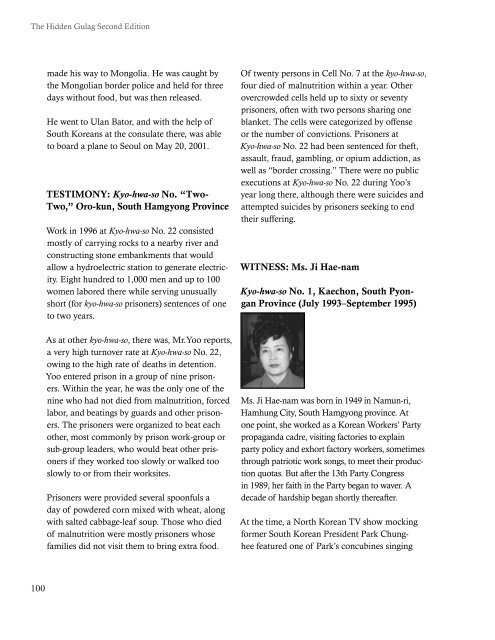<strong>The</strong> <strong>Hidden</strong> <strong>Gulag</strong> Second Editionmade his way to Mongolia. He was caught bythe Mongolian border police and held <strong>for</strong> threedays without food, but was then released.He went to Ulan Bator, and with the help ofSouth <strong>Korea</strong>ns at the consulate there, was ableto board a plane to Seoul on May 20, 2001.TESTIMONY: Kyo-hwa-so No. “Two-Two,” Oro-kun, South Hamgyong Prov<strong>in</strong>ceWork <strong>in</strong> 1996 at Kyo-hwa-so No. 22 consistedmostly of carry<strong>in</strong>g rocks to a nearby river andconstruct<strong>in</strong>g stone embankments that wouldallow a hydroelectric station to generate electricity.Eight hundred to 1,000 men and up to 100women labored there while serv<strong>in</strong>g unusuallyshort (<strong>for</strong> kyo-hwa-so prisoners) sentences of oneto two years.As at other kyo-hwa-so, there was, Mr.Yoo reports,a very high turnover rate at Kyo-hwa-so No. 22,ow<strong>in</strong>g to the high rate of deaths <strong>in</strong> detention.Yoo entered prison <strong>in</strong> a group of n<strong>in</strong>e prisoners.With<strong>in</strong> the year, he was the only one of then<strong>in</strong>e who had not died from malnutrition, <strong>for</strong>cedlabor, and beat<strong>in</strong>gs by guards and other prisoners.<strong>The</strong> prisoners were organized to beat eachother, most commonly by prison work-group orsub-group leaders, who would beat other prisonersif they worked too slowly or walked tooslowly to or from their worksites.Prisoners were provided several spoonfuls aday of powdered corn mixed with wheat, alongwith salted cabbage-leaf soup. Those who diedof malnutrition were mostly prisoners whosefamilies did not visit them to br<strong>in</strong>g extra food.Of twenty persons <strong>in</strong> Cell No. 7 at the kyo-hwa-so,four died of malnutrition with<strong>in</strong> a year. Otherovercrowded cells held up to sixty or seventyprisoners, often with two persons shar<strong>in</strong>g oneblanket. <strong>The</strong> cells were categorized by offenseor the number of convictions. Prisoners atKyo-hwa-so No. 22 had been sentenced <strong>for</strong> theft,assault, fraud, gambl<strong>in</strong>g, or opium addiction, aswell as “border cross<strong>in</strong>g.” <strong>The</strong>re were no publicexecutions at Kyo-hwa-so No. 22 dur<strong>in</strong>g Yoo’syear long there, although there were suicides andattempted suicides by prisoners seek<strong>in</strong>g to endtheir suffer<strong>in</strong>g.WITNESS: Ms. Ji Hae-namKyo-hwa-so No. 1, Kaechon, South PyonganProv<strong>in</strong>ce (July 1993–September 1995)Ms. Ji Hae-nam was born <strong>in</strong> 1949 <strong>in</strong> Namun-ri,Hamhung City, South Hamgyong prov<strong>in</strong>ce. Atone po<strong>in</strong>t, she worked as a <strong>Korea</strong>n Workers’ Partypropaganda cadre, visit<strong>in</strong>g factories to expla<strong>in</strong>party policy and exhort factory workers, sometimesthrough patriotic work songs, to meet their productionquotas. But after the 13th Party Congress<strong>in</strong> 1989, her faith <strong>in</strong> the Party began to waver. Adecade of hardship began shortly thereafter.At the time, a <strong>North</strong> <strong>Korea</strong>n TV show mock<strong>in</strong>g<strong>for</strong>mer South <strong>Korea</strong>n President Park Chungheefeatured one of Park’s concub<strong>in</strong>es s<strong>in</strong>g<strong>in</strong>g100
<strong>The</strong> <strong>Hidden</strong> <strong>Gulag</strong> Second Editionan apparently popular South <strong>Korea</strong>n pop song,“Don’t Cry <strong>for</strong> Me, Younger Sister (Hong-do).Ms. Ji was taken with the song and its melodyand memorized it. On a lunar calendar holidayco<strong>in</strong>cid<strong>in</strong>g with Christmas day, December 25,1992, Ji and four other women had an even<strong>in</strong>gsong party <strong>in</strong> Hamju-kun, South Hamgyongprov<strong>in</strong>ce. At this party, she taught the song tothe other women. Overheard by neighbors, shewas reported to the authorities, and arrested<strong>for</strong> s<strong>in</strong>g<strong>in</strong>g a South <strong>Korea</strong>n song. First, Ji wastaken to the An-jeon-bu (People’s Safety Agency)jail <strong>in</strong> Hamju-kun <strong>for</strong> fifteen days, and then tothe An-jeon-bu police jail <strong>in</strong> Myungchon-kun,<strong>North</strong> Hamgyong prov<strong>in</strong>ce. Dur<strong>in</strong>g her pre-trialdetention, she was beaten and sexually abusedby a detention-facility guard. Mortified at hermistreatment by the young guard, who was <strong>in</strong>his early twenties, Ji tried to commit suicide byswallow<strong>in</strong>g pieces of cement.<strong>The</strong> other four women at the song party weresentenced to eight months of <strong>for</strong>ced labor.Dur<strong>in</strong>g the <strong>in</strong>vestigation of Mrs. Ji’s role as thesong leader, the charge of falsify<strong>in</strong>g documentsto get more food rations was added to the chargeof “disrupt<strong>in</strong>g the socialist order”—“Articlefifty-someth<strong>in</strong>g,” she recalls. She was sentencedto three years of rehabilitation-through-laborat the woman’s prison Kyo-hwa-so No. 1 atKaechon, South Pyongan prov<strong>in</strong>ce (<strong>for</strong> her Testimonyabout No. 1, see below).After serv<strong>in</strong>g two years and two months of herthree-year sentence, <strong>in</strong> September 1995, Mrs.Ji, along with fifty other “light crime” prisoners,was released on the occasion of the fiftiethanniversary of <strong>Korea</strong>’s liberation from Japaneseoccupation. She returned to Hamju-kun, but asa <strong>for</strong>mer prisoner, felt that doors were closedto her. As the economy deteriorated, she wasunable to make ends meet as a peddler andresorted to sell<strong>in</strong>g her blood at transfusion centers.Hungry and disillusioned about her futureprospects, she fled to Ch<strong>in</strong>a <strong>in</strong> September 1998,but she was almost immediately caught by a traffickerand sold to a physically de<strong>for</strong>med Ch<strong>in</strong>eseman who locked her up as a “sex toy” <strong>for</strong> sevenmonths be<strong>for</strong>e she was able to escape. She thenmade her way to Weihai, where she worked <strong>in</strong> arestaurant and saved what little money she could.She eventually teamed up with six other <strong>North</strong><strong>Korea</strong>ns <strong>in</strong> Ch<strong>in</strong>a and stole a boat to try to get toSouth <strong>Korea</strong> by sea, but the eng<strong>in</strong>e broke down.<strong>The</strong> boat filled with water on rough seas and hadto be towed back to shore by Ch<strong>in</strong>ese fishermen.Shortly thereafter, Ji and her fellow <strong>Korea</strong>nescapees stole another boat and aga<strong>in</strong> set out tosea, but this boat was <strong>in</strong>tercepted by the authoritiesand the amateur sailors turned them over toCh<strong>in</strong>ese border guards.Taken to the Dandong detention center <strong>in</strong> Ch<strong>in</strong>a,Mrs. Ji was <strong>for</strong>cibly repatriated to <strong>North</strong> <strong>Korea</strong>and sent to the Bo-wi-bu (National SecurityAgency) police jail <strong>in</strong> S<strong>in</strong>uiju, where there weretwenty-five women and thirty men—all tal-buk-ja(“escaped <strong>North</strong> persons”). While <strong>in</strong> this Bo-wibujail, she was beaten with broomsticks, <strong>for</strong>cedto kneel <strong>for</strong> hours at a time, and made to dothe “stand-up-sit-down” exercise to the po<strong>in</strong>tof collapse, usually after thirty to <strong>for</strong>ty m<strong>in</strong>utes.Some of the younger women were kept <strong>in</strong> solitaryconf<strong>in</strong>ement and sexually abused, Ji reports.After a month, she was sent to the S<strong>in</strong>uiju jipkyul-so(detention center). But a week later onDecember 25, 1999, she was released as part of alarger pardon <strong>for</strong> persons repatriated from Ch<strong>in</strong>a.Fear<strong>in</strong>g she would be constantly watchedand possibly re-arrested, Ji made her way to101



